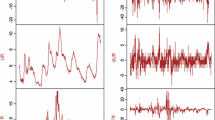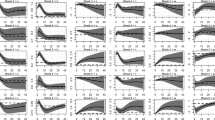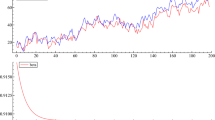Abstract
Modern empirical macroeconomic models, known as structural autoregressions (SVARs) are dynamic models that typically claim to represent a causal order among contemporaneously valued variables and to merely represent non-structural (reduced-form) co-occurence between lagged variables and contemporaneous variables. The strategy is held to meet the minimal requirements for identifying the residual errors in particular equations in the model with independent, though otherwise not directly observable, exogenous causes (“shocks”) that ultimately account for change in the model. In nonstationary models, such shocks accumulate so that variables have discernible trends. Econometricians have conceived of variables that trend in sympathy with each other (so-called “cointegrated variables”) as sharing one or more of these unobserved trends as a common cause. It is possible for estimates of the values of both the otherwise unobservable individual shocks and the otherwise unobservable common trends to be backed-out of cointegrated systems of equations. The issue addressed in this paper is whether and in what circumstances these values can be regarded as observations of real entities rather than merely artifacts of the representation of variables in the model. The issue is related, on the one hand, to practical methodological problems in the use of SVARs for policy analysis—e.g., does it make sense to estimate of shocks or trends in one model and then use them as measures of variables in a conceptually distinct model? The issue is also related to debates in the philosophical analysis of causation—particularly, whether we are entitled, as assumed by the developers of Bayes-net approaches, to rely on the causal Markov condition (a generalization of Reichenbach’s common-cause condition) or whether cointegration generates a practical example of Nancy Cartwright’s “byproducts” objection to the causal Markov condition.




Similar content being viewed by others
Notes
Most discussions of Bayes nets focus on directed acyclical graphs, in which causation is strictly one-way. But this is not essential, and it is characteristic of structural econometrics—going back to its foundations in Haavelmo’s (1943, 1944) seminal work—to be concerned with simultaneous (mutual) or cyclical causal relations.
“Causes on the right” is a common, but not always respected, convention in econometrics. It is sometimes helpful to represent the causal relationship more explicitly: Cartwright (2007, p. 13) suggests “\(\hbox {c}^{=}\)” and Hoover (2001, p. 40) suggests “\(\Leftarrow \)” as directed causal equalities.
There can also be deterministic trends in which the value of a variable depends noncausally and deterministically on time. Our concern here is only with stochastic trends.
The distribution is typically assumed to have mean of zero, which can be guaranteed by including a constant in the conditioning set, which is equivalent to an innocuous normalization of the measurements of the variables; and the distribution is often assumed to be normal or Gaussian, which can be justified in many circumstances by considerations that need not concern us here.
Other sorts of restrictions may also be identifying so long as they reduce the dimensionality of the parameter space to be no greater than the dimensionality of the data space.
In fact, Hoover (2001, chs. 8–10) investigates methods of using such changes of regime within a stable causal structure to extract information about the causal structure itself.
Acyclic graphs that have the same skeletons (i.e., the same variables are connected by causal arrows without attention to their direction) and the same unshielded colliders are observationally equivalent (Pearl 2000, theorem 1.2.8, p. 19). An unshielded collider is a pattern in which two variables that are not connected directly are the source of causal arrows that point into the same third variable. Figure 1 is an example of an unshielded collider.
Equation (11) follows from (10) by lagging (10) and substituting the expression into the right-hand side of (10) to eliminate for \(x_{t-1}\). This introduces a term \(\rho ^{2}x_{t-2}\), which is eliminated in the same way. After \(n\) such substitutions, we are left with an expression involving the shocks and \(\rho ^{n}x_{t-n}\). As \(n \rightarrow \infty \), this term approaches zero, and the expression on the right-hand side of (11) remains.
See Hoover (2001, pp. 166–170) for an analogous case.
After having tweaked the commonplace example of cointegration as man following a drunk with the addition of a brother following the man, I discovered the structurally identical explication in Murray (1994), in which the drunk is followed by two dogs rather than two brothers.
The notion of spurious or nonsense correlations goes back to Yule (1926). Sober (2001) provides a time-series example. He suggests that two trending series, the price of bread in Britain and sea levels in Venice are correlated because they are both trending upward. This is spurious correlation because the series are trending and, therefore, nonstationary; so that ordinary correlation measures that were designed with reference to stationary probability distributions (e.g., Pearson’s correlation coefficient) do not bear the same relationship to nonstationary distributions and do not in the nonstationary case indicate probabilistic dependence. See Hoover (2003) for a detailed discussion of Sober’s example. Hoover (2009) and especially Hoover (2007) addresses spurious correlations that arise from a variety of sources. The common characteristic of all types of spurious correlation seems to be that they apply the wrong probability model to the data and, therefore, use unwarranted probabilities in the second step of the two-step procedure for causal inference mentioned in Sect. 1—which reinforces the importance of getting the first, statistical step right.
When the hypothesis is accepted, \(z\) is said to be weakly exogenous (see Juselius 2006, ch. 11, sections 1 and 2).
References
Batterman, R. W. (2001). The devil in the details: Asymptotic reasoning in explanation, reduction and emergence. Oxford: Oxford University Press.
Boumans, M. (2005). How economists model the world into numbers. London: Routledge.
Cartwright, N. (1991). Replicability, reproducibility, and robustness: Comments. History of Political Economy, 23(1), 143–155.
Cartwright, N. (1993). Marks and probabilities: Two ways to find causal structure. In F. Stadler (Ed.), Scientific philosophy: Origins and development (pp. 113–119). Dordrecht: Kluwer.
Cartwright, N. (2007). Hunting causes and using them: Approaches in philosophy and economics. Cambridge: Cambridge University Press.
Claveau, F. (2013). The independence condition in the variety-of-evidence thesis. Philosophy of Science, 80(1), 94–118.
Cooper, G. F. (1999). An overview of the representation and discovery of causal relationships using Bayesian networks. In C. Glymour & G. F. Cooper (Eds.), Computation, causation, and discovery (pp. 3–64). Menlo Park, CA: American Association for Artificial Intelligence and Cambridge, MA: MIT Press.
Frisch, R. (1938). Statistical versus theoretical relations in economic macro-dynamics, reprinted in O. Bjerkholt (Ed.) In Foundations of modern econometrics: The selected essays of Ragnar Frisch (Vol. 1). Aldershot: EdwardElgar.
Duarte, P. G., & Hoover, K. D. (2012). Observing shocks. In H. Maas & M. Morgan (Eds). Histories of observation in economics, supplement to history of political economy, 44(5), 226–249.
Haavelmo, T. (1943). The statistical implications of a system of simultaneous equations. Econometrica, 11(1), 1–12.
Haavelmo, T. (1944) The probability approach in econometrics. Econometrica 12(Supplement), iii–115.
Hacking, I. (1983). Representing and intervening: Introductory topics in the philosophy of the natural sciences. Cambridge: Cambridge University Press.
Heckman, J. J. (2000). Causal parameters and policy analysis in economics: A twentieth century perspective. Quarterly Journal of Economics, 115(1), 45–97.
Hendry, D. F. (1995). Dynamic econometrics. Oxford: Oxford University Press.
Hood, W. C. & T. Koopmans (Eds.). (1953). Studies in econometric method, Cowles Commission monograph (Vol. 14, pp. 1–26). New York: Wiley.
Hoover, K. D. (1995). Comments on Cartwright and Woodward: Causation, estimation, and statistics. In D. Little (Ed.), On the reliability of economic models: Essays in the philosophy of economics. Dordrecht: Kluwer.
Hoover, K. D. (2001). Causality in macroeconomics. Cambridge: Cambridge University Press.
Hoover, K. D. (2003). Nonstationary time series, cointegration, and the principle of the common cause. British Journal for the Philosophy of Science, 54(4), 527–551.
Hoover, K. D. (2004). Lost causes. Journal of the History of Economic Thought, 26(2), 149–164.
Hoover, K. D. (2007) Probability and structure in econometric models, unpublished working paper, Duke University [early version of Hoover (2009)], downloadable from: http://public.econ.duke.edu/~kdh9/Source%20Materials/Research/Probability%20and%20Structure%2019%20September%202007.pdf.
Hoover, K. D. (2009). Probability and structure in econometric models. In Logic methodology and philosophy of science: Proceedings of the thirteenth international congress (pp. 497–513). London: College Publications.
Hoover, K. D. (2011). Counterfactuals and causal structure. In P. M. K. Illari, F. Russo, & J. Williamson (Eds.), Causality in the sciences (pp. 338–360). Oxford: Oxford University Press.
Hoover, K. D. (2013). The role of hypothesis testing in the molding of econometric models. Erasmus Journal for the Philosophy of Economics, 6(2), 42–65.
Hoover, K. D., & Jordà, Ò. (2001). Measuring systematic monetary policy. Federal Reserve Bank of St. Louis Review, 83(4), 113–137.
Hoover, K. D., & Perez, S. J. (2000). Three attitudes towards data-mining. Journal of Economic Methodology, 7(2), 195–210.
Hoover, K., Johansen, S., & Juselius, K. (2008). Allowing the data to speak freely: The macroeconometrics of the cointegrated vector autoregression. American Economic Review, 98(2), 251–255.
Humphreys, P. (1989). The chances of explanation: Causal explanations in the social, medical, and physical sciences. Princeton: Princeton University Press.
Johansen, S., & Juselius, K. (2012). An asymptotic invariance property of the common trends under linear transformation of the data. Department of Economics, University of Copenhagen, Discussion Paper No. 10-30
Juselius, K. (2006). The cointegrated VAR: Methodology and Applications. Oxford: Oxford University Press.
Koopmans, T. C. (Ed.). (1950). Statistical inference in dynamic economic models, Cowles Commission monograph 10. New York: Wiley.
Mayo, D. & Spanos, A. (2013). Ontology and methodology in statistical modeling. In Paper presented at the conference ontology and methodology, 4–5 May 2013 at Virginia Tech.
Murray, M. P. (1994). A drunk and her dog: An illustration of cointegration and error correction. The American Statistician, 48(1), 37–39.
Papineau, D. (1991). Correlations and causes. British Journal for the Philosophy of Science, 42(3), 397–412.
Pearl, J. (2000). Causality: Models, reasoning, and inference. Cambridge: Cambridge University Press.
Perrin, J. (1913[1990]). Atoms. Woodbridge, CT: Ox Bow Press.
Qin, D., & Gilbert, C. (2001). The error term in the history of time series econometrics. Econometric Theory, 17(2), 424–450.
Reichenbach, H. (1956). The direction of time. Berkeley: University of California Press.
Rudebusch, G. D. (1998a). Do measures of monetary policy in a VAR make sense? International Economic Review, 39(4), 907–931.
Rudebusch, G. D. (1998b). Do measures of monetary policy in a VAR make sense? A reply to Christopher A. Sims. International Economic Review, 39(4), 943–948.
Simon, H. A. (1996). The sciences of the artificial (3rd ed.). Cambridge, MA: MIT Press.
Simon, H. A., & Ando, A. (1961). Aggregation of variables in dynamic systems. Econometrica, 29(2), 111–138.
Simon, H. A., & Iwasaki, Y. (1988). Causal ordering, comparative statics, and near decomposability. Journal of Econometrics, 39(1/2), 149–173.
Sims, C. A. (1998). Comment on Glenn Rudebusch’s ‘Do measures of monetary policy in a VAR make sense? International Economic Review, 39(4), 933–941.
Sims, C. A. (1999). The role of interest rate policy in the generation and propagation of business cycles: What has changed since the ‘30s? In Fuhrer, J. C. & Schuh, S. (Ed.) Beyond shocks: What causes business cycles. Federal Reserve Bank of Boston Conference Series, No. 42 (pp. 121–60). Boston: Federal Reserve Bank of Boston.
Sober, E. (2001). Venetian sea levels, British bread prices, and the principle of the common cause. British Journal for the Philosophy of Science, 52(2), 331–46.
Spanos, A. (1989). On rereading Haavelmo: A retrospective view of econometric modeling. Econometric Theory, 5(3), 405–429.
Spanos, A. (1990). The simultaneous equations model revisited: Statistical adequacy and identification. Journal of Econometrics, 44(1), 87–108.
Spanos, A. (1995). On theory testing in econometrics: Modeling with nonexperimental data. Journal of Econometrics, 67(2), 189–226.
Spirtes, P., Glymour, C., & Scheines, R. (2000). Causation, prediction, and search (2nd ed.). Cambridge, MA: MIT Press.
van Fraassen, B. (1980). The scientific image. Oxford: Oxford University Press.
Walras, L. (1874[1954]). Elements of pure economics, translated by William Jaffe. Homewood, IL: Richard Irwin.
Woodward, J. B. (2003). Making things happen: A theory of causal explanation. Oxford: Oxford University Press.
Yule, G. U. (1926). Why do we sometimes get nonsense-correlations between time-series? A study in sampling and the nature of time-series. Journal of the Royal Statistical Society, 89(1), 1–63.
Author information
Authors and Affiliations
Corresponding author
Additional information
Prepared for the conference on Ontology & Methodology at Virginia Tech 4–5 May 2013.
Rights and permissions
About this article
Cite this article
Hoover, K.D. The ontological status of shocks and trends in macroeconomics. Synthese 192, 3509–3532 (2015). https://doi.org/10.1007/s11229-014-0503-5
Received:
Accepted:
Published:
Issue Date:
DOI: https://doi.org/10.1007/s11229-014-0503-5




